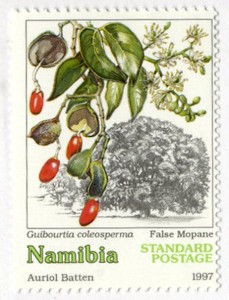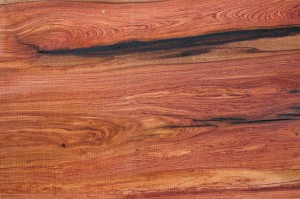African Rosewood
Note the coloration and complexity of African Rosewood. Many interesting features in this species.
Taxonomy:
Kingdom: Plantae – Plants
Subkingdom: Tracheobionta – Vascular plants
Superdivision: Spermatophyta – Seed plants
Division: Magnoliophyta – Flowering plants
Class: Magnoliopsida – Dicotyledons
Subclass: Rosidae
Order: Fabales
Family: Fabaceae – Pea family
Genus: Guibourtia
Species: coleosperma
Janka Hardness (pounds-force): 2090
Description: Grain is anything from straight to highly distinct and rippled. African Rosewood can also have some very interesting features, depending on the tree and the cut. Generally speaking, however, this species is less figured than Bubinga.
Location: Southern Africa, namely: Angola, Botswana, Cameroon, Swaziland, Zambia, Zimbabwe, Namibia.

The seed pods and foliage of an African Rosewood are featured on this Namibian stamp. Follow this link if you are fluent in Japanese and collect stamps for much more information.
Common Aliases: Bastermopane, False mopane, M’chibi, Machibi, Mtjibi, Mucibe, Muxibe, Muzauri, Rhodesian copalwood, Rhodesian mahogany, and Rhodesian teak.
Performance: African Rosewood generally saws without difficulty. It is a very durable wood, and is also better than average in resistance to insects.
Affordability: $$$$ Cheaper in Europe than in the United States. Therefore, deals exist for African rosewood, but timing is everything with this import.
Common Uses: Tools, agricultural implements, boats, cabinetry, veneers, flooring, fine furnishings, heavy construction, plywood, railroad ties, turnings, wheels.
From: The Wood Explorer:
Common Name(s): African Rosewood
Scientific Name: Guibourtia coleosperma
Distribution: Central and southern Africa
Tree Size: 35-70 ft tall, 1-3 ft trunk diameter
Average Dried Weight: 46-52 lbs/ft3
Basic Specific Gravity: .66
Hardness: 2,090 lbf
Rupture Strength: 14629 lbf/in2
Elastic Strength: 1,326,000 lbf/in2
Crushing Strength: 7,260 lbf/in2
Shrinkage: Radial: 3%, Tangential: 7%, T/R Ratio: 2.33
This versatile and durable wood is suitable for interior or exterior applications. It also remains relatively workable. Additionally, it’s rot resistance makes it a great choice for an array of purpose.
